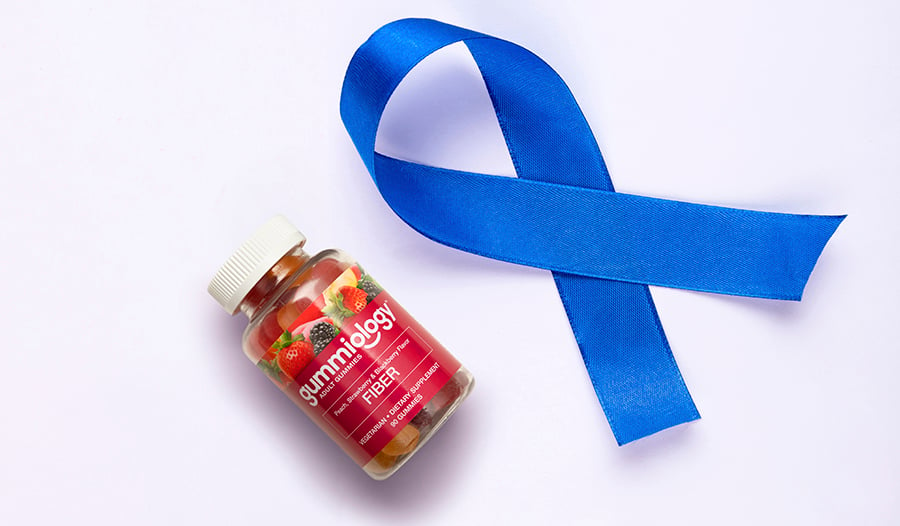6 Natural Ways To Keep Your Colon Healthy
DISCLAIMER:This blog does not intend to provide diagnosis...
- In this article:
- Anatomy And Function Of The Colon
- How The Colon Impacts Overall Human Health
- What Can Go Wrong with Colonic Health
- 6 Evidence-Based Methods for Preventing Colon Issues and Caring for Your Colon Long-Term

The colon is an incredible organ that makes up 1/5 of our digestive tracts. It helps us absorb vitamins like B12; create nutrients like vitamin K, biotin, and short-chain fatty acids; regulates water and electrolytes in our bloodstreams, and eliminates the byproducts of cellular metabolism and hormone production.
If you have questions about the colon, though, you’re not alone. Most people are never taught about the wide array of functions the colon performs for our health each day. Did you know, for example, that the colon and its functions help to regulate bone health, immunity, blood clotting, and more?
In this article, we’ll cover what the colon is, how it impacts health, and how you can keep your colon healthy with nutrition, lifestyle changes, and regular screening.
Anatomy And Function Of The Colon
The colon is a hollow tube of muscular tissue that is approximately five feet long in the average adult. This tube is divided into several sections: the cecum and ileocecal valve; the ascending colon, transverse colon, descending colon, and sigmoid colon, which terminates at the rectum.
Each part of the colon has a different role to play in human health. The anatomy of each part of the colon helps to give it special abilities. For example, the ascending, transverse, and descending colon contains chambers called haustra, which look like small pockets. The word haustra comes from the Latin word for container or bucket—and that’s how they look! Haustra hold the digested food and water mixture that came from the small intestines for long enough periods until the colonic membrane can extract the nutrients it needs before allowing the food to move through the rest of the colon and out of the body as stool.
Haustra are also home to bacteria and other microorganisms that help to extract nutrients from food. Certain bacteria, for example, produce biotin and vitamin K from the food we eat. Other bacteria ferment fibers to produce short-chain fatty acids like butyrate, which in turn fuel cellular metabolism in the colonic membrane.
Each haustrum is lined with absorptive mucosa which is composed of cells called colonocytes. The colonocytes help to regulate potassium, sodium, water, chloride, bicarbonate, and other electrolyte concentrations both inside and outside of the colon. This, in turn, helps us to regulate the electrolyte balance in our bloodstream.
If we zoom out from looking at the ascending, transverse, and descending parts of the colon, we can see the very first part of the colon, which is called the cecum. It’s located just above the right hip bone, and you may even be able to feel it and move it around when it’s full of digesting foods. It will feel like a small water balloon when it’s very full.
The cecum is attached to the appendix and contains a valve that allows digested food to pass from the small intestines and into the bloodstream. This valve is called the ileocecal valve and is the site of two important things in the body. First, it’s where our vitamin B12 is absorbed if we have a healthy gut. Second, it’s an important back-stop that prevents the backward flow of items from the large intestine into the small intestine. We’ll cover more of this below in the colonic disorders section, but just know that when this valve doesn’t work properly, you won’t feel well and you’re more likely to experience something called small intestinal bacterial overgrowth (SIBO), among other issues.
As you can see, the colon has many parts, layers, and anatomical structures that help it perform each of its important functions.
How The Colon Impacts Overall Human Health
The colon is responsible for nutrient absorption and production, as well as the elimination of wastes from the body. To say that these processes are critical for optimal human health is a complete understatement!
The Colon Helps to Produce Vitamin K and Biotin
The colon is home to many bacteria that manufacture vitamin K and biotin from the foods we eat. Vitamin K is required for the synthesis of several clotting factors, which help our blood form scabs and stop bleeding when a wound occurs. Certain forms of vitamin K (like K2) are also involved in bone turnover and calcium metabolism. When food sources of vitamin K, like natto and leafy green vegetables, are inadequate in the diet, bacterial production of vitamin K becomes important for preventing symptoms of nutritional deficiency.
Biotin is required for blood sugar management and the health of hair, skin, and nails, and for adequate maintenance of zinc. Similar to vitamin K, it’s manufactured by colonic bacteria and can help fill the gaps if our nutritional intake of biotin falls short. Biotin deficiency can lead to rashes, depression, seizures, hair loss, nail issues, and more.
For all of these reasons, we want a colon that contains enough healthy bacteria.
Absorption of Minerals and Fluid
The colon helps to regulate hydration by absorbing water from the foods we eat. Additionally, the colonic membrane pulls electrolytes like potassium, calcium, sodium, chloride, and more from foods and into our bloodstreams. These minerals are used to create electricity in our nervous systems, catalyze enzymatic reactions that create cellular energy, and maintain fluid balance and blood pressure in our cardiovascular system. You can imagine that a deficiency in any one of the minerals—whether due to poor nutrition or poor colonic health—could have a powerful, wide-reaching, and profound impact on overall wellbeing, but particular for heart and nerve health.
Elimination of Toxins
Something I wish more people knew about the human body is that, while the liver filters toxins from the bloodstream, it’s actually the colon that eliminates those toxins from the body. Our livers process the waste products of enzymatic reactions in our bodies, put them through phase one and phase two digestion in the hepatocytes, and then excrete the waste product into bile, which is then excreted into the digestive tract. Once in the digestive system, those bile-bound-toxins bind to fiber. That fiber and bile combination is supposed to then be packaged into stool once it reaches the colon and then excreted routinely—at least once a day—to keep our body’s toxic burden low. When your colon is healthy and you’re eating the right foods—this happens naturally.
What Can Go Wrong with Colonic Health
Inflammatory Bowel Diseases (IBD)
Crohn's and ulcerative colitis are inflammatory conditions that affect colonic membranes. They can lead to ulcers, bleeding, nutrient malabsorption, pain, and more. When colonic membranes are chronically inflamed and damaged, this can lead to nutrient deficiencies over time. These conditions also increase the risk of colon cancer if left untreated.
Colon Cancer
Colorectal cancer is the third most common type of cancer worldwide. An estimated two million people across the globe had colon cancer in 2020. Risk factors for colon cancer include low-fiber diets, inactivity, alcohol consumption, being overweight, and low vitamin D status. All of these risk factors can impact DNA synthesis in the colon and other tissues. Because abnormal DNA production and regulation is the root cause of tumor initiation and growth, keeping DNA production healthy in the colon is important.
Dysmotility
The muscles of the colon move food through it by contracting at regular rates and by exchanging water and electrolytes with surrounding vascular and tissues. This process of moving food through the gut is called “motility.” When motility is abnormal, food either moves through the colon too fast—which results in diarrhea—or too slow, which results in constipation. We can classify abnormal bowel transit time as “dysmotility,” which means abnormal movement. When dysmotility becomes chronic, it impacts the colon’s ability to perform its basic functions of nutrient production, nutrient absorption, and detoxification.
Dysbiosis and SIBO
The microbiome in the gut is carefully balanced amongst many important types of microorganisms, including bacteria and yeast. In general, having an abundance of “good” bacteria (also known as probiotics) helps to prevent the overgrowth of pathogenic or opportunistic bacteria and yeast that cause problems in the gut.
There are entire fields of study that focus on the microbiome, and so many studies to read through and analyze! I boil it down for my clients by explaining it this way: all bacteria survive by using fuel. They produce waste products as a part of their cellular metabolism. Some of the waste products are actually beneficial for human health. Other waste products, like methane and hydrogen, can cause problems if they’re produced in amounts that are too high for our bodies to cope with, or if they’re produced in the wrong places in the body.
In general, we want an abundance of good bacteria in the large intestine, and we want those bacteria to stay there and not migrate to other places. Having a healthy colon with a healthy ileocecal valve is key to preventing the migration of bacteria from the colon into places they shouldn’t go—like the small intestine. When colonic bacteria migrate into the small intestine, we can get symptoms like gas, bloating, cramping, nutrient malabsorption, diarrhea, constipation, and more. Collectively, this disorder of microbiota and the symptoms it causes is referred to as small intestinal bacterial overgrowth or SIBO. If you haven’t heard of it, consider yourself lucky! And thank your colon for doing its job of keeping its bacteria in just the right place.
Infection
Sometimes a pathogen takes up residence in the colon and turns an otherwise healthy organ into a hotbed of infection. Most people are familiar with C. diff, a dangerous infection that can be fatal if left untreated. The best defense against colonic infections is good food and water hygiene and a healthy microbiome that can fight off pathogenic microorganisms when we encounter them. I'll explain how to accomplish this below.
6 Evidence-Based Methods for Preventing Colon Issues and Caring for Your Colon Long-Term
Taking care of your colon is like taking care of any other part of your body. It requires routine maintenance and an evidence-based approach. While you won’t be able to necessarily “see” the effects of caring for your colon since it’s located internally, you’ll be able to “feel” the effects in the form of healthier digestion, more regular bowel movements, and symptom-free trips to the bathroom.
Additionally, because caring for your colon improves the health of every other system of your body, you can look forward to enjoying better overall health, clearer skin, healthy nervous system function, and more from your efforts. Here are the key ways to care for your colon each day.
1. Consume Enough Fiber
Every single publication on preventing colon cancer has established that increasing consumption of fiber is directly related to amplifying colon health and decreasing the risk of colorectal cancer. This is because fibers help to balance the microbiome, increase motility, and provide the bulk needed to move toxins through our colon and out of the body. You should aim for at least 25 grams of fiber per day to maintain good colonic health. Populations that consume closer to 50 grams per day have the lowest risk of colon cancer of any group of people on earth.
2. Drink Water
The large intestine is constantly combining water, digested food, fiber, and electrolytes to form stool. Without enough water, stool can’t move effectively through the colon and it gets stuck. This is known as constipation. Constipation is actually defined as less than one bowel movement per day, which surprises most people! Drinking enough water each day is key to forming stool that’s the right consistency to move easily through your colon regularly. If you’re like many of my clients, you may need help remembering to drink enough water. Don’t be afraid to set alarms on your phone, use water bottles that light up—whatever it takes! You can also consume water through tasty drinks like tea. If you have kidney or other chronic health issues, ask your doctor how much water is right for you.
3. Exercise
Our bodies use the musculature in our colons to move stool through at a regular rate. But moving your body yourself also helps! Movements like walking, running, jumping, and twisting create vibrations in the gut that help maintain a healthy rate of motility. Additionally, exercise helps to increase lymphatic movement, which aids with detoxification. It makes sense that studies show us that lack of movement is linked to poor colon health long-term. Don’t let it be the case for you!
4. Sleep Enough
Sleep is a foundational part of health and lack of sleep has been found to increase the risk of colitis and other colonic issues. See your doctor if you are struggling to get enough sleep.
5. Don’t Smoke or Over-Drink
Smoking cigarettes and consuming alcohol are both linked with increased risks of colon cancer and inflammatory bowel diseases. Make a plan with your doctor to quit smoking and commit to consuming less than three alcoholic drinks a week to improve your colonic health.
6. Get Regular Screening
Your colon is impossible to see from the outside, and that is why it’s so important to see your doctor regularly and have them run the easy tests that technology has allowed us to develop to check on colon health. There are several options for doing this, from at-home testing to colonoscopies. Your doctor will know what you need, but here’s the real conversation I want to have with you if you’re at home reading right now.
Colonoscopies are safe, effective, and the only way to truly see inside the colon and catch major issues like colon cancer early—before they become life-threatening. If your doctor has recommended a colonoscopy, get it. It’s estimated that 53,000 people will die of colorectal cancer in the United States this year alone. Many of these deaths could be prevented if they were caught earlier with screening. Please, don’t skip your screening. Listen to your doctor when they tell you it’s time for a colonoscopy. Is the day-long prep for a colonoscopy uncomfortable? Sure. But it’s also a great chance to clear out your colon, detox naturally, and make sure you don’t have cancer. Get your colonoscopy as directed and get them regularly if you’re over 50. Aside from that, sleep enough, eat a healthy diet full of fiber, stop smoking, get enough vitamin D, and keep moving. Your colon and other organs will thank you for it.
When it comes to colon health and reducing the risk for colorectal cancer and other diseases, you are in the driver's seat! I hope this article leaves you feeling empowered and motivated to care for your colon and your whole body using natural and preventive options that we know truly work.
References:
- Aune, D., et al. “Dietary Fibre, Whole Grains, and Risk of Colorectal Cancer: Systematic Review and Dose-Response Meta-Analysis of Prospective Studies.” BMJ, vol. 343, no. nov10 1, 10 Nov. 2011, pp. d6617–d6617, www.ncbi.nlm.nih.gov/pmc/articles/PMC3213242/, 10.1136/bmj.d6617. Accessed 1 Mar. 2021.
- Azzouz, Laura L, and Sandeep Sharma. “Physiology, Large Intestine.” Nih.gov, StatPearls Publishing, 27 July 2020, www.ncbi.nlm.nih.gov/books/NBK507857/#article-24030.r1. Accessed 2 Mar. 2021.
- Braasch-Turi, Margaret, and Debbie C. Crans. “Synthesis of Naphthoquinone Derivatives: Menaquinones, Lipoquinones and Other Vitamin K Derivatives.” Molecules, vol. 25, no. 19, 29 Sept. 2020, p. 4477, www.ncbi.nlm.nih.gov/pmc/articles/PMC7582351/, 10.3390/molecules25194477. Accessed 1 Mar. 2021.
- “Cancer Today.” Iarc.fr, 2020, gco.iarc.fr/today/online-analysis-multi-bars?v=2020&mode=cancer&mode_population=countries&population=900&populations=900&key=asr&sex=0&cancer=39&type=0&statistic=5&prevalence=0&population_group=0&ages_group%5B%5D=0&ages_group%5B%5D=17&nb_items=10&group_cancer=1&include_nmsc=1&include_nmsc_other=1&type_multiple=%257B%2522inc%2522%253Atrue%252C%2522mort%2522%253Afalse%252C%2522prev%2522%253Afalse%257D&orientation=horizontal&type_sort=0&type_nb_items=%257B%2522top%2522%253Atrue%252C%2522bottom%2522%253Afalse%257D. Accessed 1 Mar. 2021.
- “Colon Cancer.” American Family Physician, vol. 97, no. 10, 2021, p. 658, www.aafp.org/afp/2018/0515/p658-s1.html. Accessed 2 Mar. 2021.
- Dou, Ruoxu, et al. “Vitamin D and Colorectal Cancer: Molecular, Epidemiological and Clinical Evidence.” British Journal of Nutrition, vol. 115, no. 9, 9 Mar. 2016, pp. 1643–1660, www.ncbi.nlm.nih.gov/pmc/articles/PMC4890569/, 10.1017/s0007114516000696. Accessed 1 Mar. 2021.
- Litvak, Yael, et al. “Colonocyte Metabolism Shapes the Gut Microbiota.” Science, vol. 362, no. 6418, 29 Nov. 2018, p. eaat9076, www.ncbi.nlm.nih.gov/pmc/articles/PMC6296223/, 10.1126/science.aat9076. Accessed 1 Mar. 2021.
- Manson, JoAnn E., et al. “Vitamin D Supplements and Prevention of Cancer and Cardiovascular Disease.” New England Journal of Medicine, vol. 380, no. 1, 3 Jan. 2019, pp. 33–44, pubmed.ncbi.nlm.nih.gov/30415629/, 10.1056/nejmoa1809944. Accessed 1 Mar. 2021.
- “Microbiota, Inflammation and Colorectal Cancer.” International Journal of Molecular Sciences, vol. 18, no. 6, 20 June 2017, p. 1310, www.ncbi.nlm.nih.gov/pmc/articles/PMC5486131/, 10.3390/ijms18061310. Accessed 2 Mar. 2021.
- Mock, Donald M. “Biotin: From Nutrition to Therapeutics.” The Journal of Nutrition, vol. 147, no. 8, 12 July 2017, pp. 1487–1492, www.ncbi.nlm.nih.gov/pmc/articles/PMC5525106/, 10.3945/jn.116.238956. Accessed 2 Mar. 2021.
- Mondul, Alison M, et al. “Vitamin D and Cancer Risk and Mortality: State of the Science, Gaps, and Challenges.” Epidemiologic Reviews, vol. 39, no. 1, 1 Jan. 2017, pp. 28–48, www.ncbi.nlm.nih.gov/pmc/articles/PMC5858034/, 10.1093/epirev/mxx005. Accessed 2 Mar. 2021.
- O’Keefe, Stephen J. D. “Diet, Microorganisms and Their Metabolites, and Colon Cancer.” Nature Reviews Gastroenterology & Hepatology, vol. 13, no. 12, 16 Nov. 2016, pp. 691–706, www.ncbi.nlm.nih.gov/pmc/articles/PMC6312102/#R26, 10.1038/nrgastro.2016.165. Accessed 1 Mar. 2021.
- “Office of Dietary Supplements - Vitamin K.” Nih.gov, 2017, ods.od.nih.gov/factsheets/vitaminK-HealthProfessional/. Accessed 2 Mar. 2021.
- Ogawa, Youichi, et al. “Biotin Is Required for the Zinc Homeostasis in the Skin.” Nutrients, vol. 11, no. 4, 24 Apr. 2019, p. 919, www.ncbi.nlm.nih.gov/pmc/articles/PMC6520690/, 10.3390/nu11040919. Accessed 2 Mar. 2021.
- Song, Mingyang, et al. “Nutrients, Foods, and Colorectal Cancer Prevention.” Gastroenterology, vol. 148, no. 6, May 2015, pp. 1244-1260.e16, www.ncbi.nlm.nih.gov/pmc/articles/PMC4409470/, 10.1053/j.gastro.2014.12.035. Accessed 2 Mar. 2021.
- Tjalsma, Harold, et al. “A Bacterial Driver–Passenger Model for Colorectal Cancer: Beyond the Usual Suspects.” Nature Reviews Microbiology, vol. 10, no. 8, 25 June 2012, pp. 575–582, pubmed.ncbi.nlm.nih.gov/22728587/, 10.1038/nrmicro2819. Accessed 2 Mar. 2021.
- Uronis, Joshua M., et al. “Modulation of the Intestinal Microbiota Alters Colitis-Associated Colorectal Cancer Susceptibility.” PLoS ONE, vol. 4, no. 6, 24 June 2009, p. e6026, www.ncbi.nlm.nih.gov/pmc/articles/PMC2696084/, 10.1371/journal.pone.0006026. Accessed 2 Mar. 2021.
- Xiao, Qian, et al. “Prediagnosis Sleep Duration, Napping, and Mortality among Colorectal Cancer Survivors in a Large US Cohort.” Sleep, vol. 40, no. 4, 9 Feb. 2017, www.ncbi.nlm.nih.gov/pmc/articles/PMC5806565/, 10.1093/sleep/zsx010. Accessed 2 Mar. 2021.

 By Dr. Kate Henry, N.D.
By Dr. Kate Henry, N.D.


